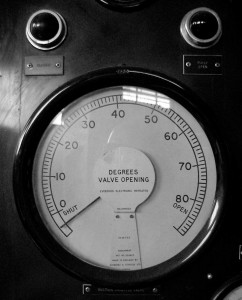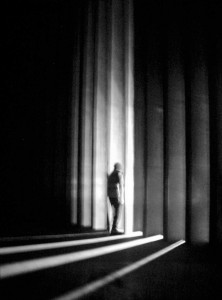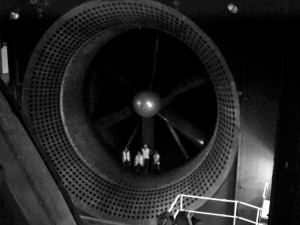What is paradise? For me it has been flying the Observatine surveillance airplane – my ongoing research project into embodied topological flight - from a commercial runway at Artists Airshow – a one day event curated by Arts Catalyst in the UK.

Detail from a console in the Transonic Wind Tunnel control room. Photo: Zina Kaye
Inspired by the recent decommissioning of the classified Royal Aircraft Establishment site in Farnborough, the day comprised demonstrations and talks – located in the former military aviation facility, adjacent to the airport where the biannual International Air Show takes place. The event was attended by over 400, including a range of people that wouldn’t normally see a tactical media show.
We were given access to explore the workshops before installing our works. Some buildings were in disrepair, others waited for demolition. The core of the site is to become a museum.
The 24′ wind tunnel’s giant wooden fan propeller is an object of worship to fans of sculpture and big engineering alike, likewise the abutting return air duct is a majestic study in concrete. In the thermos-like Transonic Wind Tunnel chalk markings on the centre wall poetically attest to the last experiment made. Ducking under pipes, I expected to see ghosts of scientists in lab coats working steel knobs, noting their observations into the log books still at the site.

Concrete gills in the 24' Wind Tunnel air duct. Photo: Zina Kaye
Curator Rob Le Frenais selected a range of media for the show. Simon Faithful released a weather balloon carrying a chair and camera that reached the edge of space, whilst Tim Knowles caged a balloon to capture its Pollockian automatic drawing. Stefan Gec projected a video recorded at Star City of a cosmonaut in a centrifuge having g-force applied. Nearby, Luke Jerram displayed a mercury-filler trough in the shape of a Spitfire onto which light was shone, reflecting a quivering apparition on the wall. Anna Piva and Edward George of Flow Motion projected their work onto a screen at the open end of the Transonic Tunnel. The accompanying 4-channel sound track electrified the space.
Observatine flew for about 30 minutes in total, showing pictures on three televisions close to the runway. The acrobatics that pilot Bob Young performed over Farnborough manifested dizzy abandonment and viewers called out giddy whoops. The work resonated with Louise K. Wilson’s installation Loop using footage shot from the cockpit of a Slingsby Firefly. Miles Chalcraft let off a large rocked attempting to shower the site with tears.

From left to right: Zina Kaye, Bob Young, Peter Spurway & Joy Young inside the propellor assembly of the 24' Wind Tunnel. Photo: Mr Snow
The finale was a sky drawing by Anne Bean using timed flares with ribbons attached making vertical marks on a steely grey canvas.
Networking with peers and experts, we made time to share practical knowledge on various topics. Sally Davies – a genuine rocket scientist – gave some insight into my microphone noise problem caused by parts in the video transmitter moving due to engine vibration, and made an introduction to a specialist in her group. Simon’s ham radio expert, Giles, tuned into everything on site and generously captured some of the Observatine footage allowing us to compare equipment.
BMFA’s Peter Spurway came to offer support. Special thanks go to Arthur Rumble from Farnborough Airport who invited Observatine to be the first plane allowed to fly on a commercial airfield to our knowledge. At the Airshow, Ewen Chardronnet invited Mr. Snow and I to a residency in Dunkerque titled Semaphore, part of the Trans- Mapping Workshop Series, from where this report is filed.
This project was assisted by the Conference and Workshop Fund of the Australian Network for Art and Technology.
Artists Airshow was held at Farnborough, UK on 12 September 2004.
Zina Kaye
Watch More
 This work is licensed under a Creative Commons Attribution-NonCommercial-ShareAlike 3.0 Australia.
This work is licensed under a Creative Commons Attribution-NonCommercial-ShareAlike 3.0 Australia.






